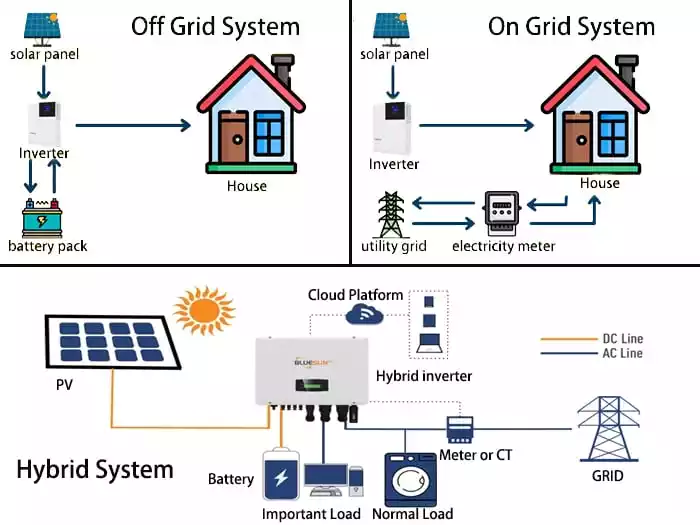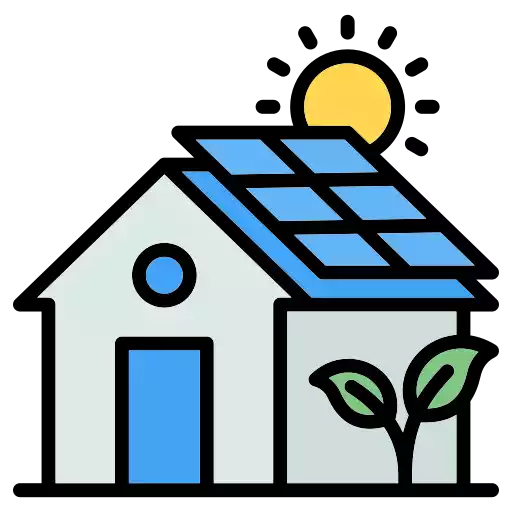- SY No.121/7 Mudigere village, Kasba hobli, Gubbi taluk, Tumkur District.
- +91 91413 54304

Solar Rooftops
A rooftop solar power system is a photovoltaic (PV) setup that generates electricity using solar panels installed on the roof of a residential, commercial, or industrial building. These solar rooftop solutions cater to a diverse range of customers, including residential, commercial, industrial, and institutional sectors.
Residential: Solar rooftop systems for homes provide long-term, free, and uninterrupted electricity while contributing to a greener environment. They are easy to install, require minimal maintenance, and offer significant energy savings over time.
Commercial & Industrial: For businesses and industries, rooftop solar solutions guarantee a solid return on investment by significantly lowering electricity bills and promoting sustainable energy practices.
On-grid solar system
The on-grid solar rooftop system transforms solar energy into grid power, connecting directly to a utility grid (such as BESCOM in Bangalore). This system operates only when the grid is active. It features a series of solar panels mounted on the roof, which capture solar radiation and convert it into electrical energy. This energy is then passed through an inverter, converting it into alternating current that is compatible with grid power. The system can generate surplus electricity, meeting the energy needs of residential, commercial, and industrial sectors. Solar rooftop on-grid systems are reliable, easy to install, and have a 25-year lifespan. They efficiently utilize existing roof space to generate clean energy, helping reduce electricity costs.
Off-Grid Solar system
An off-grid solar system operates independently, eliminating the need for a connection to the power grid. Instead, it relies on a battery backup to store solar energy generated during the day.
This system includes solar panels, a charge controller, batteries, mounting structures, and an inverter. Solar panels capture sunlight during daylight hours, and the battery stores excess energy to power electrical appliances at night.
Self-sustaining and perfect for locations without access to power grids, this setup provides reliable and autonomous energy solutions.
Hybrid Solar System
Experience the best of both worlds with our hybrid solar solution combos, combining the functionality of on-grid and off-grid systems for unmatched reliability, efficiency, and performance. Our hybrid solar system connects to the grid through net metering and features a battery backup to store excess power. Solar panels capture energy, which is then converted into electricity by a hybrid solar inverter.
The standout benefit of our hybrid solar system is its power backup capability, ensuring you have continuous electricity even during power outages. The battery backup stores surplus power generated during peak sunlight hours, providing seamless energy access whenever you need it.

Home & Residential Societies

Commercial & Industrial Establishments

Institutions

Large Enterprises
Components of a rooftop solar array:
-
Solar panels generate carbon-free electricity when exposed to sunlight. Typically composed of silicon, each panel contains several smaller solar cells, with most panels having six cells. Multiple panels connected together form a solar array.
-
Mounting clamps, usually made of aluminum brackets and stainless steel bolts, secure the panels to each other on the roof and attach them to the rails. The design of these clamps varies to accommodate different roof and rail configurations.
-
Racking or rails are metal structures positioned parallel on the roof to support the panels. Ensuring that the rails are level is crucial for proper panel alignment.
-
Mounts, often L-shaped brackets, connect the rails and the entire solar array to the roof surface. These mounts are bolted through flashing into the roof rafters. Their design varies to fit different roof types and materials.
-
Flashings are metal plates that create a water-resistant seal between the mounts and the roof. Caulk is often used to seal the flashing to the roof, and it resembles a metal roof shingle.
-
DC/AC wiring connects the panels to a micro inverter or string inverter. To prevent weathering and cable deterioration, cables should not touch the roof surface or hang from the array.
-
Micro inverters, installed underneath each panel, convert the DC power generated by the panels into AC power suitable for the grid. They optimize performance when panels are shaded and can provide detailed data on individual panel performance.